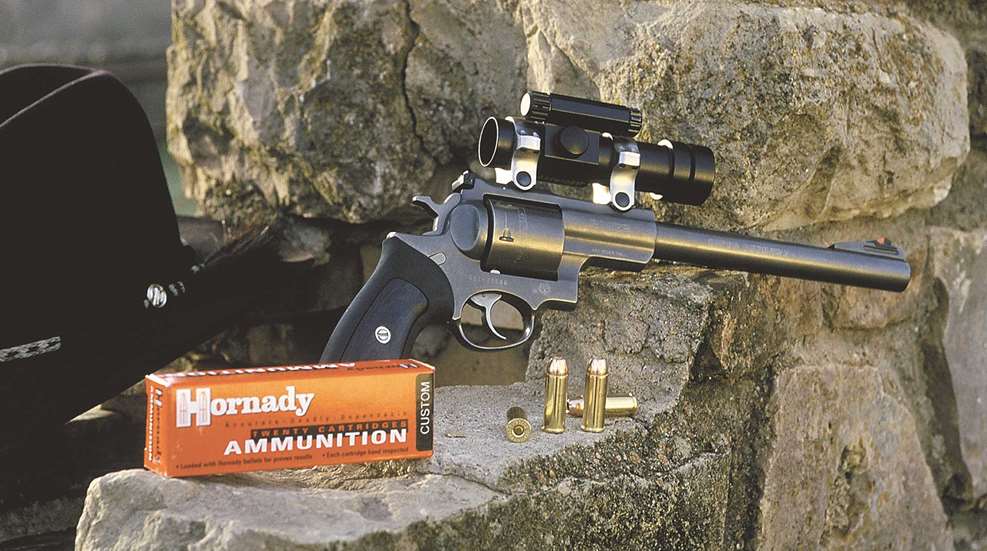
This feature article, “An Element of Excitement: Handgun Hunting Big Game,” appeared originally in the November 2004 issue of American Rifleman. To subscribe to the magazine, visit the NRA membership page and select American Rifleman as your member magazine.
The Right Tool For The Job
There are basically two types of hunting handguns these days, revolvers and single-shots. Both have their strong points and their downsides.
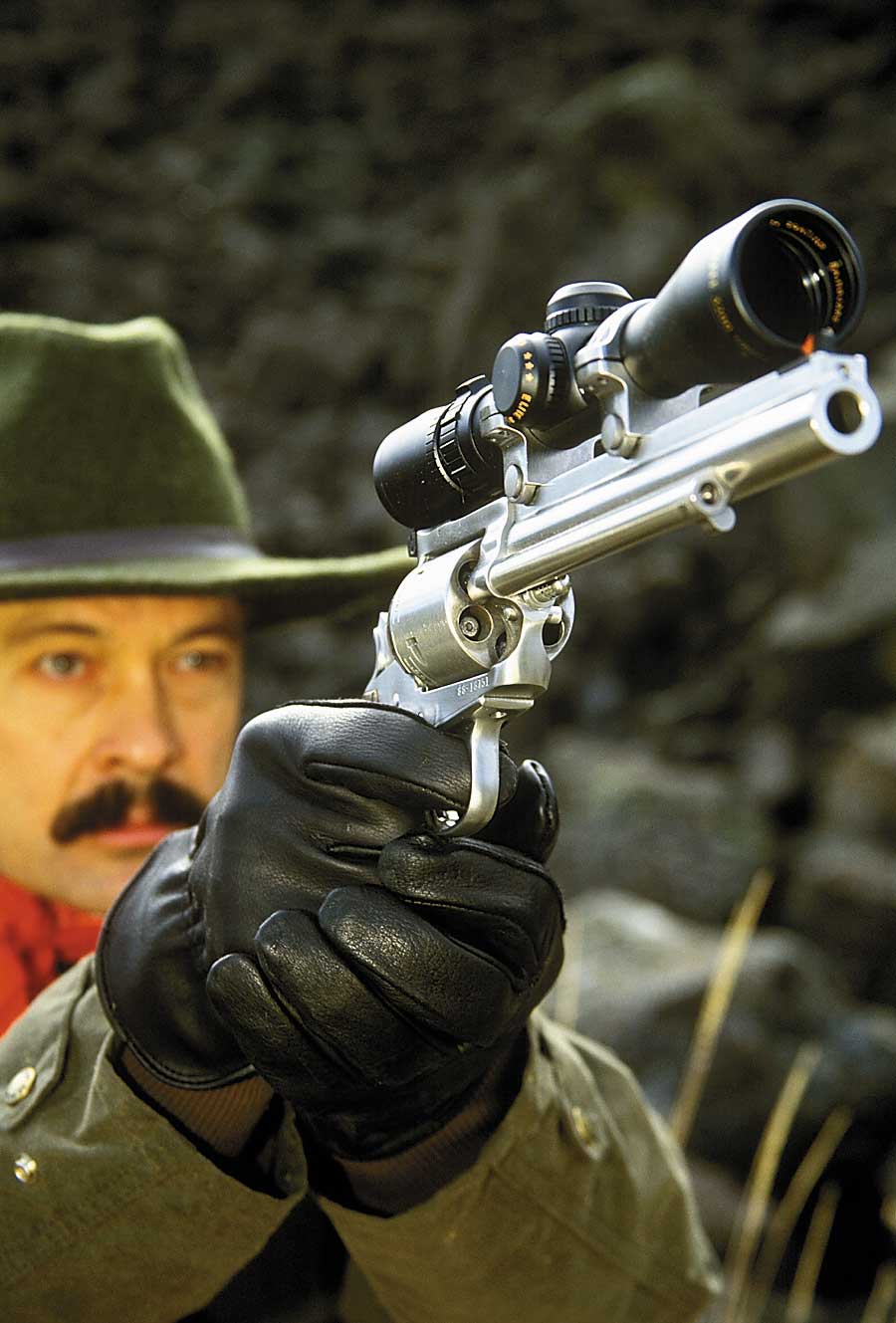
A revolver has the advantage of five or six shots without reloading. They can be single-action or double-action and will almost universally use straight-walled cartridges. They rely on bullet diameter and bullet weight more than raw velocity to put game down. Because of the relatively low velocity and big, flat-nosed slugs, they are limited in practical range to 125 yards or so, which covers the majority of hunting situations. A few handguns are accurate enough to use at much longer range, but most revolver cartridges are running out of steam past about 150 yards.
Big-game hunting revolver cartridges start with the .357 Mag. While I have some respected friends in the industry who promote this as a deer cartridge, I’ll disagree. I have taken several deer with the .357 Mag., but find it to be lacking. I suppose it might be fine for the smaller Texas whitetails, and it’s certainly enough gun for close-range antelope, but for northern whitetails or anything larger, it’s a bit anemic.
In my opinion, revolver cartridges for deer hunting start with the .41 Rem. Mag. They also include the .44 Rem. Mag., .480 Ruger, .454 Casull, .475 Linebaugh, .50 AE and .500 S&W. The list will also include the .45 Colt if it’s loaded to modern pressures and used in strong modern revolvers such as those from Ruger. However, factory-loaded .45 Colt ammo is too mild for hunting. Mid- to heavyweight expanding bullets work well for deer hunting—for example, 220 grs. in the .41 Mag.; 240 grs. for the .44 Mag., 260 grs. in the .454 Casull. When I started handgun hunting in the 1970s, high-quality jacketed bullets for handgun hunting were as rare as an honest politician. But, things have improved today. (Well, at least the bullet options have.) We now have high-performance handgun bullets like the Nosler Partition Gold, Hornady XTP, Barnes X-Bullet and Speer Gold Dot. All these bullets are available in factory loads.
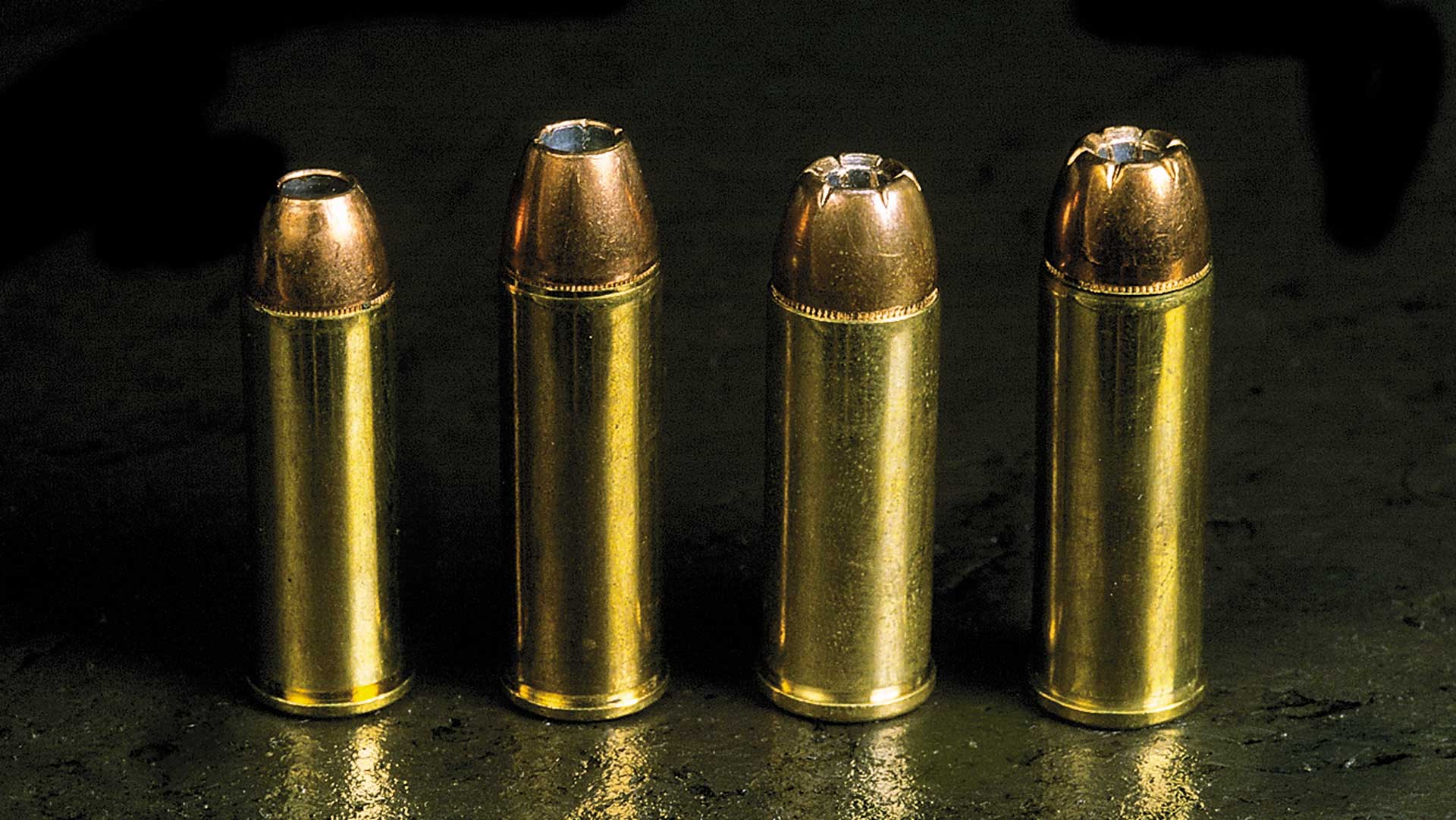
I’ll take some grief for this statement, but for anything bigger or tougher than the average whitetail deer, I would probably eliminate the .41 Mag. That includes black bears, hogs and even the big northern whitetail bucks. They really need a bigger, heavier bullet. I shot the hog mentioned earlier with a Freedom Arms Model 83 Revolver in .50 AE. The .50 AE is not a traditional revolver cartridge as it was designed for use in a semi-auto handgun, but Freedom Arms has chambered it in the Model 83 single-action. It has long suffered from a lack of really good hunting bullets, but one advantage the Freedom Arms revolver has over the gas operated semi-auto handguns in this cartridge is that it can use cast bullets. A flat-nose, hard-cast bullet turns the .50 AE into Thor’s hammer and changes its on-game performance dynamics rather dramatically. With the introduction of the .500 S&W, there have been several new bullets introduced that should work well with the .50 AE.
"Handgun hunting has evolved and matured. It’s an accepted, ethical, challenging and wonderful way to hunt big game."
I have had good luck on several other hogs and a couple of black bears with the .44 Mag., but you need to be selective about which bullets you use. Hogs are nature’s walking bullet traps. I once had a buddy who tried to shoot a big Florida boar with a 9 mm handgun. He emptied two fullsize magazines during a running battle that ended with him treed on a big brush pile with a very angry hog camped at the base. I heard all the shooting and decided I’d better investigate. The hog didn’t like me much either, but I brought a grown-up gun to the party. He ran into a .44 Mag., and that ended it. It turns out that most of the 9 mm bullets that actually hit him were stopping on the hog’s gristle shield and were doing little more than making him mad.
Bears are tough customers, too. I have spent a lot of time hunting them and working in bear camps, and I have tracked a lot of wounded black bears. When they are hit they rarely lie down like a wounded deer. They will run off with a destination in mind, and—if they don’t die en route—they will keep going until they make it there. Their feet don’t leave much in the way of tracks, and bears are notorious for skimpy blood trails. When they decide to hide, they usually crawl into a hole where you will walk right by without seeing them. Wounded bears are very hard to track and find, so you need to hit them hard and have a good exit hole for a good blood trail to follow.
When you get to game weighing more than 500 lbs., including elk, moose or the big bears, the best cartridges become an even more exclusive club. While they have all been taken with a .44 Mag., it’s on the light side, particularly for game that can bite and stomp you. The .475 Linebaugh would be fine as would the .500 S&W, but my personal favorite revolver cartridge for truly big game, (actually any big game) is the .454 Casull. I wouldn’t hesitate to tackle anything in North America with a handgun chambered for this cartridge—as long as I had the right bullets, of course.
"Handgun hunting is not just a hobby, it’s a commitment."
Straight-walled revolver cartridges are similar to 19th Century blackpowder rifle cartridges in how they kill game. Velocities are relatively low and they rely on a big, blunt and heavy bullet rather than the modern expanding, high-velocity bullets of today’s rifles. On game weighing more than 500 lbs., penetration becomes very important. The revolver bullet is already as large as a lot of expanded rifle bullets, expanding and making it larger demands a lot of energy for it to penetrate very far—energy that most revolver cartridges do not have to spare. Most experienced big-game handgun hunters will look to non-expanding or limited-expansion bullets for the big stuff. The old standby is a flat-nose, hard-cast bullet. These penetrate deep and kill game well.
The revolver is the “traditional” hunting handgun and, for a lot of hunters, it’s the only true handgun. There is certainly something inherently satisfying in packing an iron sighted six-gun while hunting. They carry well in a holster and are ready at a moment’s notice. They are tough, trouble-free and, with the right cartridge, very powerful. It’s handgun hunting in its purest form.
Single-shot handguns offer a different approach. They are the “specialty guns” of handgun hunting. Single-shots can be chambered in a straight walled “revolver” type cartridge, or they can expand the concept to the next level and use a straight-walled rifle cartridge like the .45-70 Gov’t or .450 Marlin. When chambered for these big-bore rifle cartridges, the single-shots are the bludgeons of handgun hunting. With the right bullets and loads they can handle just about anything that walks the Earth.
But, the biggest advantage in single-shot for hunting is that they can be chambered in bottle-necked rifle cartridges that are capable of long-range performance. While some performance is lost to the shorter barrels, these cartridges still shoot very flatly. These single-shot handguns are, as a rule, very accurate and are easily equipped with a scope. In fact, there is something slightly sinful in having one without optics mounted on top. As a result, if the shooter has the capability, the equipment is up to a long-range challenge.
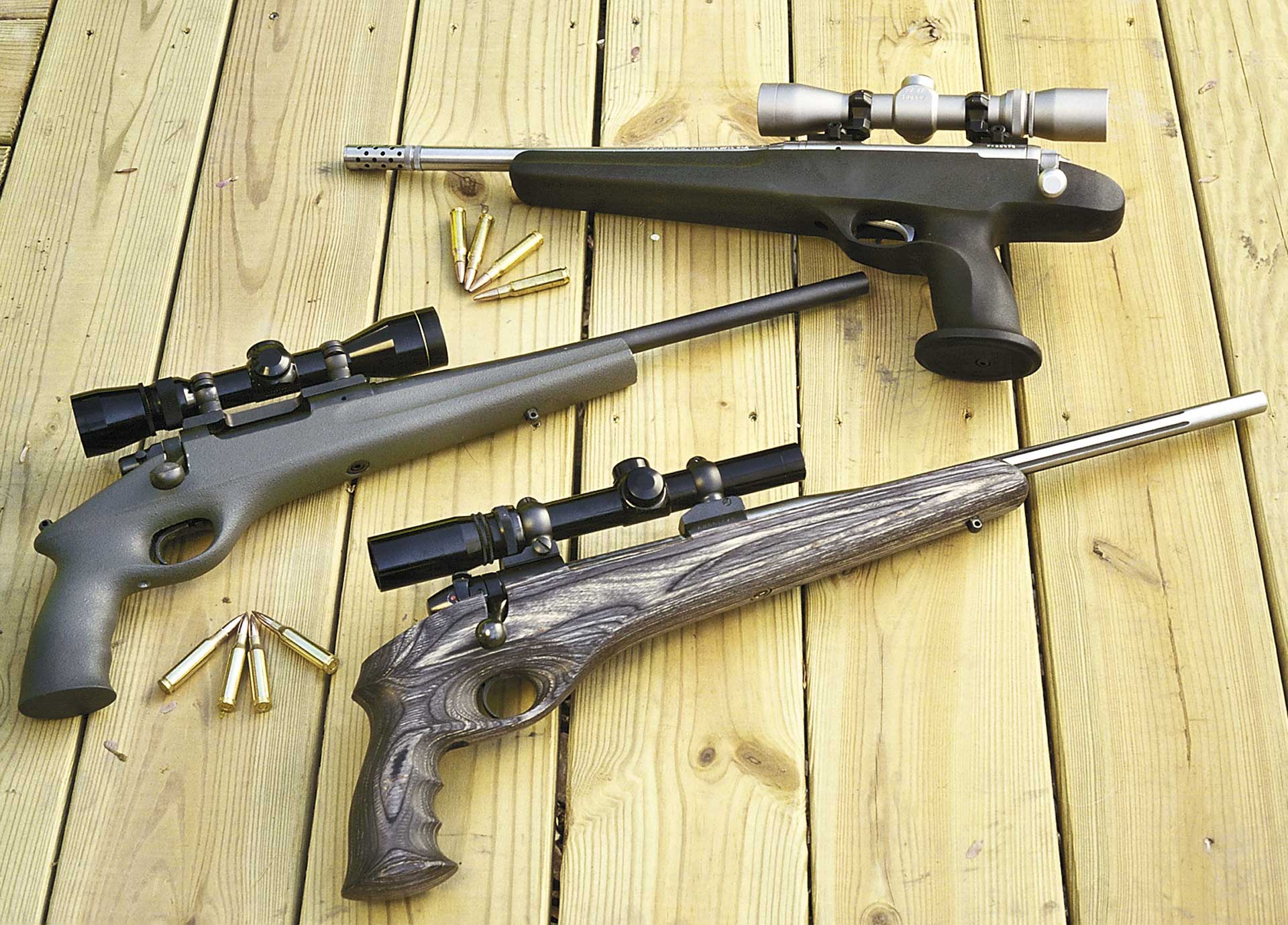
The two most popular formats for single-shots are the bolt-action and break-action. The bolt-action handgun started with the Remington XP-100, and Savage made its Striker bolt-action pistol for a number of years. Currently, Nosler offers its M48 Custom Handgun in a number of calibers, including .308 Win., 6.5 Creedmoor and 7 mm-08 Rem.
Thompson/Center’s Contender and Encore handguns are single-shots with switchable barrels so that one gun will handle a wide variety of cartridges. The Encore is the larger of the two and handles the big such as like the .450 Marlin, .270 Win. and .30-’06 Sprg. The Contender is a smaller-framed handgun that uses barrels in cartridges such as .30-30 Win. or 7x30 Waters. Recently T/C introduced in both guns one of my long time favorite hunting cartridges—the .375 JDJ. This former wildcat was developed by J.D. Jones as part of a series of handgun hunting cartridges. It’s been used to stop charging elephants, but it is just as at home in the whitetail woods. A true “hand cannon,” the .375 JDJ pushes a 220-gr. bullet to 2300 f.p.s. It’s one of the best hunting cartridges you can put in a handgun for anything from deer to grizzlies.
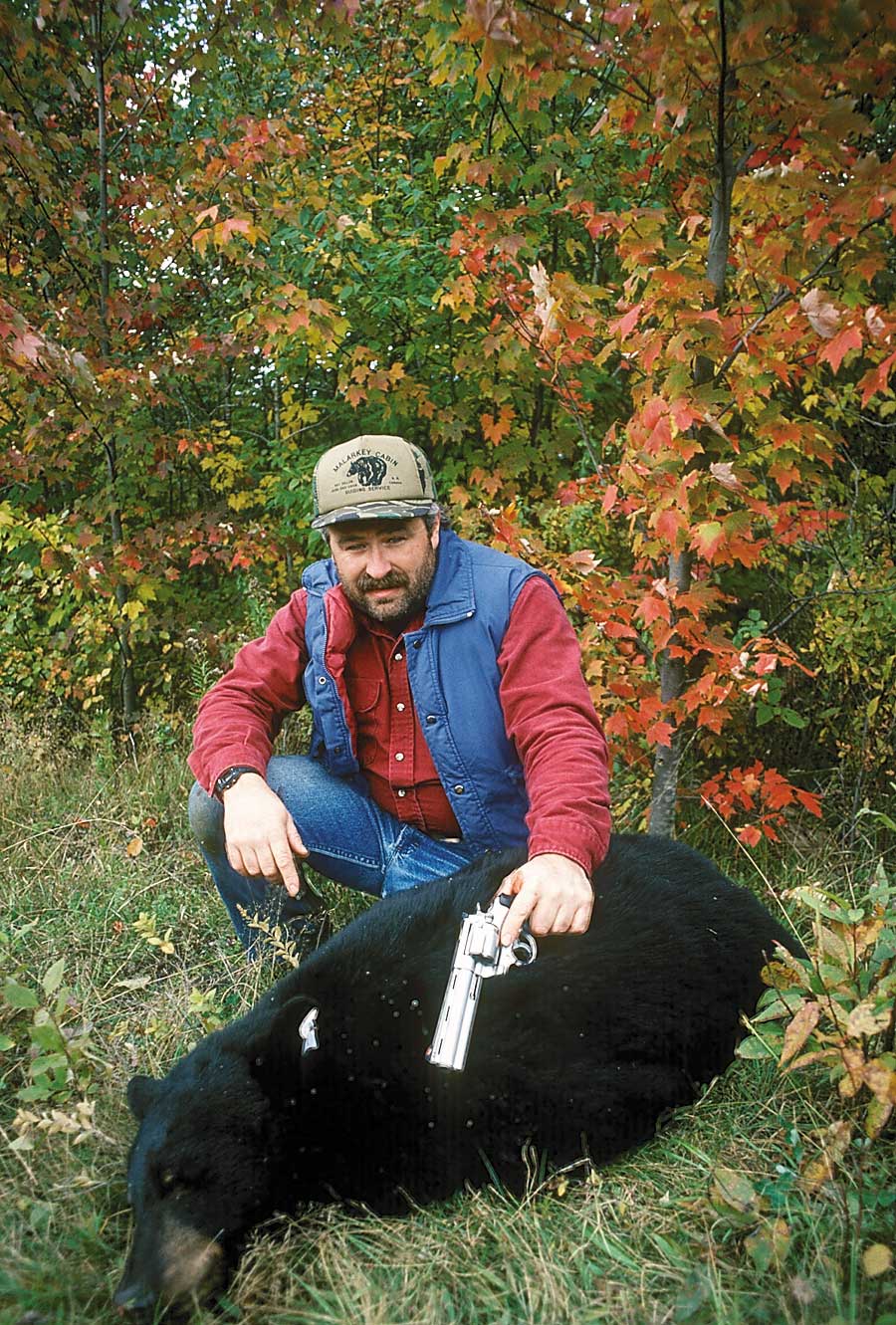
Anything that can be said about ammo and bullets for revolvers also applies to the straight-walled cartridges in a single-shot. However, when using the bottle-necked rifle cartridges consider that the shorter barrels will reduce velocity. “Soft” bullets like the Nosler Ballistic Tip will work well on deer but, as always, bigger game is best hunted with premium-quality big-game bullets.
I have an Encore handgun in 7 mm-08 Rem. that is more accurate than most rifles. I actually once won a bet by out-shooting a custom rifle at the range in an Alabama hunting camp. It’s one of my favorite handguns for hunting deer or antelope. For deer in the woods where shots are close, I like my .30-30 G2 Contender or the 7x30 Waters. But I am a big-bullet guy, and when hunting the three “Bs,” that is bears, boars and “big stuff,” I like the .45-70 Gov’t with handloads or the .450 Marlin.
With very few exceptions there are no special seasons for handgun hunters, and when we hunt with a pistol it’s because we want to. Handgun hunting is a choice that requires a commitment. But, it adds an element to big-game hunting that is always interesting and, sometimes, downright exciting.
Wild Times After Wild Boar
Riding a charging horse through thick and thorny brush in the low country of South Carolina was an experience I knew I wouldn’t regret when it ended. When it got too thick, I gladly bailed off the horse and went on by foot. The hog had clearly found the thickest patch of brush in existence, and as I worked my way into it I thought about another hog in a similar circumstance. The day before we had a big boar bayed up and, by all appearances, done for the day. Then a young dog got foolish and decided to take a nip out of his hindquarter.
The hog turned so fast the human eye couldn’t follow, drove the dog into the ground and “bulldozed” it for several bloody feet, while shredding its midsection with his tusks. That blinding speed and those razor sharp tusks were on my mind as I wormed further into the thick cane patch. When I could finally see the big boar, only about 15 ft. separated us and, suddenly, the pistol in my hand began to feel like a bad idea. All I could see was a patch of hide, and I had no idea what part of the boar’s anatomy it covered. Adrenaline overrode fear and good sense, and I inched farther into the cane tangle.
The hog turned and started at me, and I quickly planted a slug in what I believed was an important part of the pig. I lost sight of the boar, so I backed out and circled. When I finally spotted him again it was so thick that I couldn’t tell if he was on his feet or down, so I shot him again, but it wasn’t necessary, as the first shot had finished him. It took a while before my legs were steady enough to walk back to the horse.
One of my buddies describes hunting hogs as the most legal fun you can have, and I find little to argue about that description. This big tusker was one of the biggest boars I have ever taken and one of the most exciting. But then, no matter what kind of big game you are hunting, a handgun always adds an element of excitement. From my first whitetail with a handgun back in the ’70s, I have been hooked. I have used handguns during up close and personal encounters with boars and bears, for long-range prairie shooting at pronghorn antelope and for just about everything in between.
In the early years of handgun hunting there was a perception that it was a “gimmick,” a showboating trick. Reading the stories of the era about hunting polar bears with a .357 Mag. brings an understanding of that kind of thinking. But, handgun hunting has evolved and matured. It’s an accepted, ethical, challenging and wonderful way to hunt big game.
Practice Makes Perfect
Handgun hunting is not just a hobby, it’s a commitment. A rifle hunter may get away with picking up his gun and going hunting without much practice, but a handgunner cannot.
Shooting well with a handgun is about 10 times more difficult than shooting well with a rifle. Building the shooting skills takes time, and you can’t master it in a weekend or two before the season. To be good enough to hunt big game requires practice—and lots of it. The commitment is to a handgun shooting lifestyle that involves shooting a lot. On top of the inherent difficulty of shooting any handgun, big-game hunting handguns kick a lot. That recoil adds another level of difficulty to mastering shooting well. The only way to learn is practice.
The upside is that shooting handguns is a lot of fun, so it’s not like practicing is drudgery. I recently spent a weekend in New Mexico doing nothing but shooting handguns. I went through nearly two cases of ammo in my Freedom Arms .454 Casull and another case of .45 ACP in my Kimber PRO CDP, on top of a bunch of .22 LR and .45 Colt. Life was good.

































